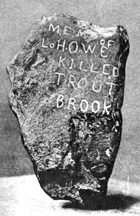

Colonel George Augustus, Viscount Howe
George Augustus, Viscount Howe, (1725-1758), was killed in a skirmish just before
Abercromby made his unsuccessful attack on Fort Ticonderoga. On the 3rd of October,
1889 a Peter Duchane and a few other workmen were digging a four-foot deep trench
near Ticonderoga in the yard of Mr. E.M. Gifford when they came across a piece of
decayed board. After some more digging, Duchane discovered a large stone and a severely
decomposed human skeleton.
This remarkable find was made very close to the point where Colonel Howe of the 55th
Foot had been killed some 130 years earlier. The curiosity of the local inhabitants
was understandably aroused by all this and upon closer examination a fragment of
a brass button and several hand-made nails were also found--possibly the rotten board
and nails were evidence of a makeshift coffin? Even more remarkable, upon closer
examination the stone--a 10-inch long by six-inch wide piece of limestone--was found
to bear the inscription "Mem of Lo Howe Killed Trout Brook."

The mysterious Tombstone found near Fort Ticonderoga
It would be easy to dismiss this remarkable find as a hoax. It is widely known that Lord Howe was interred for a time in the Schuyler family vault St. Peter's Church at Albany, and the official correspondence of General Howe's death states that his body was removed to that place. But if this is indeed the case, whose skeleton was found by the ditch diggers? The man who actually found the grave, Duchane, could not read nor write, and it is unlikely he had ever even heard of General Howe. Besides, what would he gain by staging such a hoax? One piece of contemporary correspondence, General Abercromby's dispatch of September, 1758, states: "I caused his body to be taken off the field of battle, and sent to Albany...but the weather being very hot, Brigr. Stanwix was obliged to order it to be buried." Another account states that, when the body was finally removed from the Schuyler family vault, it was said that Howe's "hair had grown to long, flowing locks, and was very beautiful"--but Howe had cut his hair short for campaign! So, the burning question still remains: if the skeleton that was found at Trout Brook really is Howe, then who was buried at St. Peter's Church?
SOURCE: The Bulletin of The Fort Ticonderoga Museum, Vol II, No. 8, Fort Ticonderoga Museum, July 1930
This page and it's links are intended strictly as a research source.
All contents of this page are © 1998 Mark Tully and/or the 55th Regiment of
Foot.
For More information, contact Mark Tully